This is the story about how a chance online meeting opened a new perspective into the scene which introduced Rudolph Valentino’s tango to the world of silent film goers…the scene which led me to the discovery of my connection to this great silent film star.
When I created this blog, it was because one night the name “Rudolph Valentino” came to my mind like a bolt out of the blue as I was looking at very old family photographs. And, when I first wrote about The Four Horsemen of the Apocalypse two years ago, just a few months into my journey with this site, I had no idea that in that film I would find my then unknown connection to Rudolph Valentino.
My discovery came about quite by accident after connecting with another member of Ancestry.com. I had joined because the pictures in the box in my closet made me want to know more about my family history. I didn’t know that this person had been doing extensive research on her family and along the way had compiled quite a bit of information about my family as it tied into her family tree. And it is this intersection of her family tree with mine that would reveal my–actually our–connection to Rudolph Valentino.
While talking, I recounted my sudden interest in Valentino and she recalled some stories that had been passed down through her family. Her interest was piqued and she began digging and started to put the pieces together. She had a worn out copy of Emily Leider’s Dark Lover and asked if I knew about it. Of course, I had already acquired the book and she pointed me toward a picture which showed the full frame of the famous tango scene in the movie which included one of her relatives, a granduncle. Next, came the revelation that my own granduncle had married into the family. It’s an indirect connection through a marriage but a connection nonetheless!! Needless to say, this was not only a shock, but also an impetus to continue researching the era during which Valentino and my family lived. This connection continues to inspire my research into the life of Rudolph Valentino. (See NOTE 1 below about the use of the term “granduncle.”)
My acquaintance from Ancestry.com and I have since exchanged a great deal of information and has graciously agreed to allow this story to be told.
In many videos the famous “tango scene” in the Four Horseman of the Apocalypse is blurry at best and most cut off the sides of the frame. But clear black and white publicity stills and colorized lobby cards from the period show the scene in much better detail. In the picture below I’ve circled one of the extras watching Valentino tango. This man is our link to Rudolph Valentino.
Who was this man?

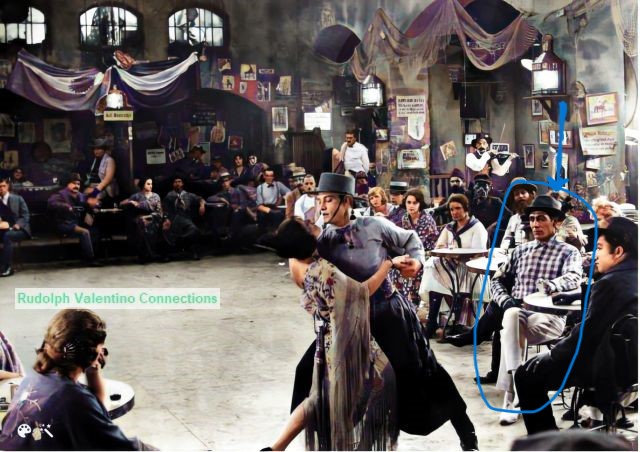
Variations of lobby cards


The clearest version of the full movie I have found uploaded to Youtube is the TCM presentation of the Turner/Channel 4 tinted restoration which features a score by Carl Davies. According to IMDb, this restoration included many scenes that had been deleted or thought to be lost. It is posted by Historic Hollywood on Youtube without a soundtrack and the timestamps below refer to this version which I chose to use as my source as it seems to be slightly clearer than other available versions. Of course, there are many short clips which have the soundtrack. Most seem to be clipped from Hollywood: Episode 6—Swanson & Valentino curated by the Youtube channel Silver Screen Classics. (NOTE: I found other uploads that include the Davis music soundtrack on foreign-based channels. I cannot vouch for how long they will stay up at Youtube. However, this version, uploaded from a channel based in Iceland does appears to meet music licensing requirements.)
There is a brief flash of this extra’s clapping hands visible to varying degrees in some of the available videos at the right edge of the screen. But he is visible in all versions of the film in two scenes: (1) after Julio (Valentino) finishes the famous tango sequence and couples return to the dance floor, there is a glimpse of this extra dancing right behind Valentino and (2) later in the film the same extra appears behind Julio’s left shoulder as he dances with Marguerite (Alice Terry) at their rendezvous at what studio publicity would call the Paris “tango palace.”
I’ve drawn the following screen shots from the Historic Hollywood channel version showing…
Frank Varanelli, The Extra

~ Min. 13:49
Frank Varanelli clapping from the sidelines

~ Min. 15:22
An angry Julio–Frank Varanelli to the rear

~Min. 42:01
Julio and Marguerite at the tango palace. Frank Varanelli to the rear
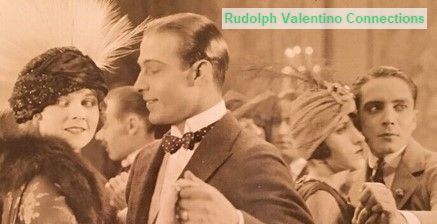
Part of a studio publicity still from the time of the film’s release clearly showing
Frank Varanelli behind Valentino’s left shoulder during the “tango palace” scene.
Frank Varanelli also would “stand in” for Valentino at times during the production.
TWO FAMILIES CONNECT
The story begins with the two granduncles that are key to this story…
Granduncle Frank #1– Frank Xavier Varanelli
Frank Xavier Varanelli, the extra I’ve identified above, was born on May 24, 1900 in Waterbury, Connecticut. There were six girls and two boys in a family–Antonio and Frank–with Frank being the younger of the two. Frank Varanelli was five years younger than Rodolfo Gugliemli, later Rudolph Valentino, who was born on May 6, 1895.

This pin holds pictures of the young Frank (Right) and his older brother Antonio (Tony) (Left). Their mother is pictured in the lower section of the pin.
Date Unknown
My Ancestry.com friend’s grandmother Concetta would marry Antonio, so she became the brother-in-law of Frank Varanelli. Therefore, he is my friend’s granduncle.
Granduncle Frank #2–Francesco William Socci
Francesco William Socci, my granduncle, was born on February 15, 1895 in Italy only a few months before the birth of Rodolfo Guglielmi (Rudolph Valentino). The latter arrived in New York on December 23, 1913; Francesco arrived a few months later on April 29, 1914. While Rodolfo would stay in New York without family, Francesco joined his older brothers in Waterbury, Connecticut. Michele had arrived in the United States on January 21, 1901 and went on to Waterbury; my grandfather Ernesto arrived on September 9, 1902 and immediately joined his older brother there. (See the Table of Contents on this site for prior posts about family histories.)
Ernesto was my mother’s father and Francesco (Frank) was her uncle; therefore, he is my granduncle Frank.

Michele (Michael) Socci in his Waterbury, Connecticut shoemaker’s shop, early 1900’s
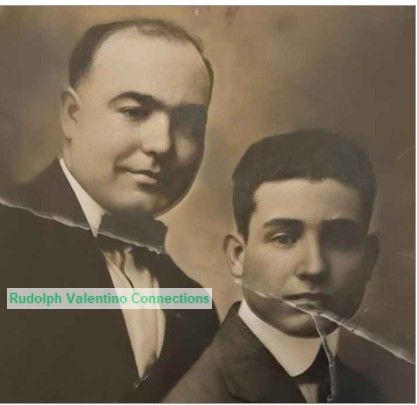
Ernesto Socci (my grandfather) with his baby brother Francesco (Frank), date unknown
Early Lives
Francesco Socci was a World War I veteran. His draft registration card dated June 5, 1917 listed his name as “Frank Mary Socci.” (Perhaps “Mary” was just a misspelled version of his Italian middle name–another brother’s middle name was “Mario.”) He was apparently sending money home to his parents in Italy as he listed them as “two dependents.” His draft registration was submitted in Waterbury and this document also reveals that he had already declared his intention to become a citizen on April 16, 1917 as Francesco Socci. When he became a U.S. citizen under the Act of May 8 (1918) at age 23 on June 25, 1918 his name had been altered and he was formally named as “Frank William Socci” in his naturalization document. By August 1918 he began his military service.

Frank in uniform. He would serve in France in the American Expeditionary Force from August 1918-June 1919.

Frank, probably after World War I
Frank Varanelli was about 5 years younger than my granduncle Frank, but, as a resident of Waterbury, Connecticut, he was required to fill out a questionnaire–“Military Census–Form No. 1”– after the state passed an act on February 7, 1917 designed to “procure certain information relative to the resources of the State.” Frank stated that he was a U.S. citizen, 17 years old, single, had one dependent to support (unspecified), and that he had no physical disabilities. He also stated that had no real technical skills but the one thing he could do was swim. The military questionnaire did not ask about one particular skill that Frank already had or would be able to develop later–apparently, he had some ability to dance.
Unlike my granduncle Frank Socci, Frank Varanelli did not enter the military during World War I. The 1920 United States Census, which was conducted on January 5th of that year, lists Frank as being 19 years old and working for a grocery store as a “truckman.”
After the war Frank Socci resided in Brooklyn and Manhattan, New York before moving to Long Island, New York. Frank was trained as a barber in Italy and worked in this trade all his life.
A Marriage–Frank Varanelli’s Niece Marries My Granduncle
My friend’s grandmother, Concetta, had a sister named Giovannina. Natalina Maria Nicolo S— was born on December 24, 1904 in Brooklyn. She was known as “Marie.” And Marie, of course, was the niece of Antonio and Frank Varanelli.
Frank Socci would meet Marie in Brooklyn, New York. Although her extended family hailed from Waterbury, they apparently had never met any of the Socci brothers there, so this was a chance meeting.
The marriage license for Frank and Marie was issued on August 30, 1923 and their wedding followed on October 21, 1923.
Marie would eventually become a nurse. Unfortunately, I have no pictures of Frank as barber.

Marie as a young nurse
Date Unknown
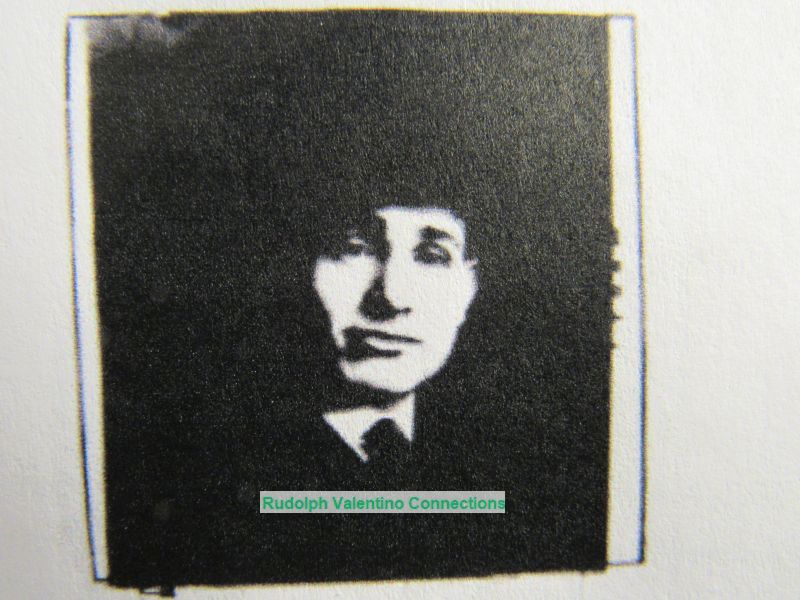
Frank’s passport application picture, dated December 7, 1921. He planned to travel to Italy to visit his parents by July 1921.

October 21, 1923
Marie (center left) and Frank (center right) flanked by their wedding party.
Frank was 28, Marie was 19.
What’s interesting is that a marriage document lists the groom’s name as Francesco, not his naturalized name, Frank.
Below is a “flow-chart” that summarizes the connection of the Varanelli-Socci families. The chart illustrates how it was my friend’s grandaunt Giovannina who would give birth to the niece of both Antonio and Frank Varanelli (my friend’s granduncles)–and how Natalina Marie would marry my granduncle Frank Socci.

So, my friend and I are connected through our granduncles by marriage…and it was her granduncle Frank who worked with Rudolph Valentino.
Frank Varanelli Moves West
…and Into Valentino’s Breakthrough Tango Scene
Marie’s uncle Frank would move west before she married Frank Socci in 1923. Sometime after the January 1920 U.S. Census canvas Frank Varanelli and his older sister Mary Patrina Varanelli left Waterbury. Mary was born about a year after Rodolfo Guigliemi (Rudolph Valentino) on June 29, 1896. Brother and sister headed west and settled in Los Angeles.
During July 1920 publicity reports were being published about the production including the dance sequences. Alice Terry and Rudolph Valentino were “rehearsing special dances” according to The Los Angeles Evening Express edition of Thursday, July 22, 1920, Page 26. A week later there was a report that Beatrice Dominguez, “a talented Spanish dancer,” would “do a dance with Rudolph Valentino” in the film (Los Angeles Daily Times, Wednesday, July 28, 1920. Part III, Page 4).
Frank Varanelli, the “truckman” who arrived in Los Angeles sometime after January 1920, soon found himself in the movie industry. He may have seen an ad in a newspaper ad or trade publication about a search for dancers. In a newspaper story published in November 1920, fed by studio publicity staff as production of The Four Horsemen of the Apocalypse was winding down, there was a detailed description about how “the French tango” promised to be “one of the features of the production.” The story actually focused on the “exhibition dance by Rudolph Valentino and Alice Terry which they had been practicing for the last month.” (NOTE: As detailed above, this item was actually first reported on in July.) A dance palace set was constructed and a “real French orchestra” was enlisted. Director Rex Ingram had a more difficult time recruiting 50 couples who could dance the tango because although the dance had been a craze a few years ago, he had to cast a wide net to find all the dancers he needed for the “tango palace” scene.
The story also states that Ingram wanted the dancers to speak French. Whether he actually found enough couples with both tango and French language skills is unknown. But Frank Varanelli was chosen to be one of these dancers in this scene as well as the earlier bar scene set in Argentina. He had no speaking part and it’s unlikely he spoke French, but he apparently could dance well enough to be chosen to be one of the final one hundred chosen from among three hundred contenders to earn a spot in the cast. (See NOTE 2 below about problems with teaching “French” extras for speaking parts.)

Director Rex Ingram “was compelled to call about 300 persons before he could get a hundred that could perform the steps to this sinuous dance.”
The Journal and Tribune, Knoxville, Tennessee
Sunday, November 7, 1920. Page 24.
Frank Varanelli
After The Four Horsemen of the Apocalypse
Frank Varanelli didn’t just do a one-off as an extra in The Four Horsemen of the Apocalypse. In fact, he had a rather dramatic turn in the original 1925 version of the Phantom of the Opera, which starred Lon Chaney, Mary Philbin and Valentino’s friend, Norman Kerry. (See NOTE 3 below about the different versions of this film.)

Here is the story passed along in 2015 to my friend from the business partner of Alex, who was the son of another of Frank’s sisters, Lena. This man (noted as “V)” was good friends with Lena and she would often talk and share stories about the family with him.
Your great Uncle Frank and Lon Chaney were good friends. Frankie learned a lot about makeup and special effects from him and he passed them on to Alex. On his occasional return to Connecticut he would love to scare the hell out of his sisters. Uncle Frankie was a stand in for Chaney and did scenes he didn't want to do or was too tired to do....In the film, the man behind the mask is your relative, Frank Varanelli.--V
This story is quite believable as Alex, who was an architectural designer, enjoyed practicing make-up design on his sisters and also trying looks on himself. He learned well, as shown in the picture (below) of one of his transformations.


In recounting the story about The Phantom of the Opera, this friend of the family revealed that Frank was in the Bal Masque de l’Opera scene, where the crowd parts and the Phantom dressed as the Red Death sweeps down the grand staircase, turns, then goes back up. This sequence was filmed in technicolor. Shortly after this sequence, there is another scene in which the Phantom descends a small staircase as he leaves the revelers on the grand staircase.
Two film historians who provide commentaries on the film discuss how Chaney acted with his body. Scott MacQueen, who commented for the 2003 DVD version of the 1929 reissue remarked about how Chaney acted like mime, “giving the film rhythm” which he thought much of the film lacked. Historian Jon Mirsalis zeroes in on the actor’s hands in the Bal Masque de l’Opera scene.
So, in which scene did Frank Varanelli wear the mask of the Phantom? It is unlikely that an extra would have been used in an early technicolor sequence of such great importance. It’s more likely that Frank stood in for the star during the less demanding, brief scene in which the Red Death quickly and straightforwardly walked down the small staircase.


How Frank and Mary Varanelli Moved in Hollywood Circles
Mary Varanelli also sang and did extra work in film and she seemed to always have her camera ready to take pictures of life in Hollywood. She would send photos back home to her and Frank’s sister Lena. Hal Roach. Tom Mix. Will Rogers. These are some of the personalities that Frank and Mary had contact with as their lives unfolded in Hollywood.
HAL ROACH
The connection of the Varanelli’s to Hal Roach was particularly interesting. Roach’s long career in Hollywood was born at the start of the silent film era and in 1921 he created the Our Gang (Little Rascals) series. Mary Varanelli took this behind-the-scene shot from the Our Gang set and also photographed her brother Frank at the studio.

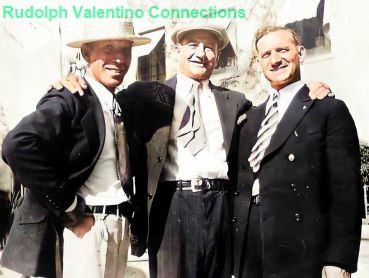
The Historic Los Angeles site is a treasure trove of information, maps, illustrations and photographs related to the development of Los Angeles, including Berkeley Square, a gated community first planned in 1903. In 1920 Roach purchased an existing house at 22 Berkeley Square where he would live many years before moving to Beverly Hills around 1934 (See NOTE 4 below). Before building a full studio, Roach would sometimes film his projects on the square and at his house. This photo from the Historic Los Angeles site shows the filming of a Stan Laurel short, A Mother’s Joy (released on December 23, 1923).

The front of Hal Roach’s house at 22 Berkeley Square, Los Angeles, circa 1923 during the filming of A Mother’s Joy starring Stan Laurel.
The highlight box provides a clue to the photos below…
Source: Historic Los Angeles website
The Varanelli siblings spent time at Roach’s house and posed for photographs on what seems to be the second-floor porch. Compare the highlighted area in the above shot to these pictures of Frank sitting on the railing and Mary posing with a pair of maids. By the time of this photo Frank was working for Roach in some position at the house. The inscription on the bottom of the photo calls him a “buttler” (sic) but it is likely that he was also acting as a chauffeur or general assistant around the house. Sadly, this house and others on Berkeley Square would be lost to highway development.


Frank Varanelli (Left) and Mary Varanelli (Above) with maids at the Hal Roche house, sometime before 1934.
AFTER VALENTINO: “SILENTS” TRANSFORM INTO “TALKIES”
WILL ROGERS and TOM MIX
Will Rogers went to Hollywood in 1918 after years on the vaudeville circuits and following his time with the Ziegfeld Follies in 1917. His first silent films were made for Goldwyn Pictures, but in 1923 he started a year-long stint with Hal Roach Studios where he made twelve films. I’ve concluded that the picture below was mostly likely taken during that year by Mary Varanelli behind the main Hal Roach Studio’s office building after looking at pictures of the building and observing the types of windows on several sides of the structure.

Will Rogers and an unknown man behind the main Hal Roach Studios building.
Inscription reads:
“William Rogers posed for me for a picture, Mary”
Frank Varanelli did some extra work with Tom Mix and actually developed a relationship with the silent movies’ “King of the Cowboys.” I don’t know when the Varanelli’s first met Tom Mix, but they were definitely friendly during the 1930’s. According to the family, Frank and Tom did socialize on a regular basis. The talkies virtually ended Mix’s prolific movie career and, after nine films at Universal Studios starting in 1932, he finally made his final film appearance in a serial in 1935. Mix drank, was married five times, had many affairs, made a lot of money and spent even more. In 1937 he bought a Cord 812 supercharged phaeton and he posed with it for Mary Varanelli; she would send the picture to her sister Lena back East. On October 12, 1940, Tom Mix died in Arizona when his car overturned after speeding through construction barriers at a bridge that had been washed away by a flash flood.


LATER YEARS IN HOLLYWOOD
Mary Varanelli continued her interest in singing and dancing and passed her performing instincts onto two of her four children–the two girls, Frances and Beatrice. As recalled by the family friend:
Auntie Mary was a singer and dancer in the movies. Both girls were beautiful. Frances was an extra in the movies and we often saw her in films. Beatrice also worked in films but not as much as her sister. Frances had a few speaking parts....She was in several scenes from "I Married An Angel" as part of an elaborate party scene. Another movie she was in was "Shanghai Gesture," there is a scene where she is in a cage that is pulled up to a window.--V
I Married and Angel was the last film Nelson Eddy and Jeannette MacDonald made together and was released in January 1942, with the New York opening in July 1942. Only trailers for this film and a few short clips are on Youtube so it’s not certain if she is visible in these scenes.
The Shanghai Gesture had its New York opening in December 1941, with a general release in January 1942. This film noir crime movie was directed by Josef von Sternberg and starred Gene Tierney, Walter Huston, and Victor Mature. The full movie is available on Youtube. At time mark 1:11:03 the sequence of cages being hoisted up outside a window as “an appetizer for our male guests” begins, first with one cage followed by a group of cages (actually four). Frances is in one of these cages.


Today, Mary Varanelli’s legacy in “show business” is alive through her granddaughter who has become an Emmy Award-winning producer (See NOTE 5 below).
LEGACIES…
Frank Varanelli, who married twice but remained childless, had no one to carry on his legacy when he eventually left the film business. He returned to the work of his youth. The United States Department of Commerce 1950 Census of Population and Housing reveals that the then 50-year-old Frank was once again working as a “truckman,” specifically as a truck driver for the Mayflower Moving Company. Frank would pass away in 1967 and his sister Mary passed in 1999.
Maria, Frank’s niece and my granduncle Frank Socci also never had children and would divorce in the mid-1940’s. Maria remarried but within a few years she become the victim of an auto accident in 1950. Frank Socci would also remarry and finally have a family, which included a daughter who was interested in acting. My granduncle Frank would work as barber well into old age, passing away in Florida in 1988 at age 93.
Of course, Rudolph Valentino would have a much greater film legacy than the extra who danced behind him on the set of a “tango palace” and a more glamorous life than this extra’s sister who enjoyed taking photographs on Hollywood back lots. And Valentino would naturally live a far more luxurious life than the extra’s niece who became a nurse and who married a barber–a marriage that created the connection to Valentino that my friend and I both share. Yes, the connection may be indirect, but it is a real connection, hidden for one hundred years, and finally brought to life now.

“What you leave behind is not what is engraved in stone monuments, but what is woven into the lives of others.”
–Attributed to Pericles, Athenian statesman
(NOTE 6)
NOTES
1. Like the term “grandparents” the terms “great-uncle” and “granduncle” are both used to designate relations two generations away. Ancestry.com uses the term “granduncle” and that is the term I’ve used in this essay. Their chart showing the relationship is located here.
2. Apparently, according to a publicity squib, the efforts to find French-speaking extras went so far that Ingram and June Mathis were trying to teach extras to speak French and finally “were induced to make up and go on long enough to portray the parts.” The Evening Star Journal, Lincoln, Nebraska. Tuesday, February 8, 1921. Page 3.
3. The original 1925 version of The Phantom of the Opera was reissued in 1929 with sound, partial Technicolor, reworked title cards, with scenes removed and new scenes added. Lon Chaney was not involved in the changes in the 1929 version. The original version exists as the New York General Release print which is available at Archive.org. The 1929 version restoration produced by Kevin Brownlow, David Gill & Patrick Stanbury features a reconstructed, synchronized soundtrack and is available here on Youtube. There are varying presentation on the details on how the film was altered and these are listed in the SOURCES below and as cited in the discussion above.
4. The house Roach moved to in 1934 was a Southern colonial mansion originally owned by Priscilla Dean and then by Pola Negri before it was purchased by Roach. In the two pages that are available from a story in Architectural Digest, Roach’s first house in Berkeley Square, which was definitely NOT a “Southern colonial mansion,” is never mentioned.
5. Mary Varanelli’s granddaughter, April Jones, provided her “Mini Bio” to the IMDb site:
April Jones is an Emmy Award-winning Executive Producer and Director known for developing and overseeing innovative content for broadcast and multi-media platforms. Collaborating with the likes of artists such as Bobby Flay, Kevin Hart, Amber Tamblyn and Ice Cube, her multi-hyphenate body of work spans prime time series, acclaimed lifestyle and culinary programming, as well as cutting edge short-form and branded content.
6. The quotation by Pericles, according to Wikiquote.org, is “likely a modern paraphrasing of a longer passage from Thucydides‘ History of the Peloponnesian War, II.43.3.” It is quoted on page 118 in Flicker to Flame: Living with Purpose, Meaning, and Happiness by Jeffrey Thompson Parker, published by Morgan James Publishing, New York, 2006.
SOURCES
Newspapers and other publications as cited in the text and NOTES.
The Four Horsemen of the Apocalypse and The Phantom of the Opera, Youtube videos as cited.
American Film Institute Catalog, Phantom of the Opera. https://catalog.afi.com/Catalog/moviedetails/11345
Architectural Digest, April 1990 “Hal Roach: A Legendary Producer’s Beverly Hills Estate” Pages 186-undetermined.
IMDb (Internet Movei Database). April Jones, “Mini Bio.”
IMDb (Internet Movie Database). The Four Horsemen of the Apocalypse. “Alternative Versions.”
IMDb (Internet Movie Database). The Phantom of the Opera. “Alternative Versions.”
The Phantom of the Opera, Wikipedia entry.
Turner Classic Movies, Hal Roach Biography, Life Events.
Turner Classic Movies, I Married an Angel. Film Details.
Turner Classic Movies, The Shanghai Gesture. Film Details.
Will Rogers, The Official Licensing Website of Will Rogers. Biography.
